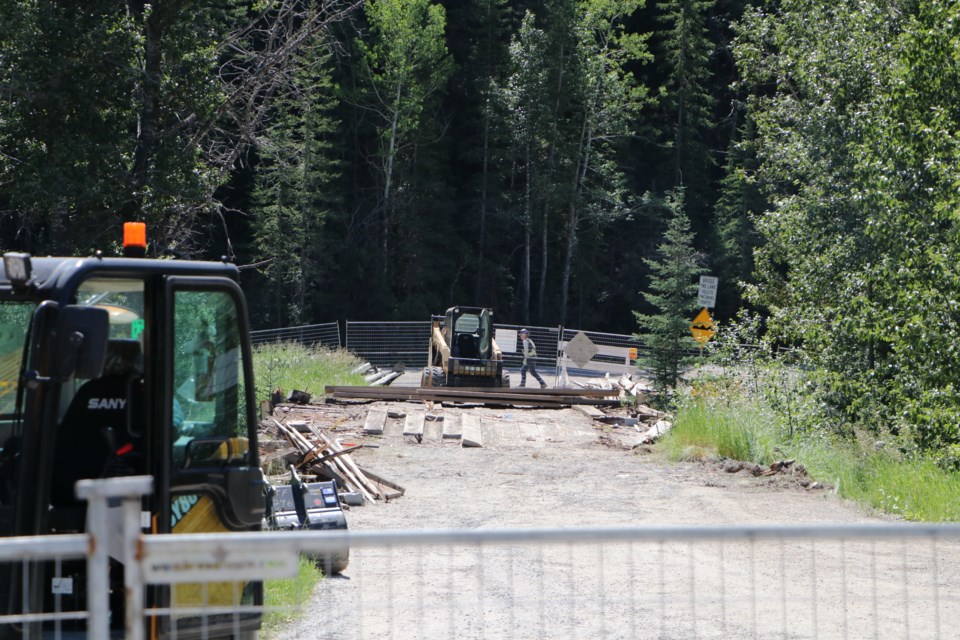Many enjoy strolling through the Historic Cochrane Ranche on a summer's day, including some of the town's wildest neighbours - bears.
Tracks from a bear wandering through the area were spotted beneath the 4 Avenue North bridge, along Bighill Creek this morning (July 21). Currently, there are construction crews on site working to replace the bridge.
The Town of Cochrane posted the report on its Facebook page just before noon, where they also shared important tips for the public to be aware of when it comes to bear safety.
The post advises residents to put away their waste and organics carts, leaving them out only in the morning that they're to be collected.
The Town also advises residents to remove potential food sources and attractants such as bird feeders, pet waste, and fruit dropped from trees, and further, to keep dogs on leashes and carry bear spray.
When it comes to coexisting with wildlife, local WildSmart ambassador Ali Morrison said it's humans' responsibility alone to ensure a positive outcome for all involved.
"They're doing everything right, they're being wild animals," said Morrison. "It's incumbent on us as people who live here to coexist with them safely."
Black bears in particular are not an uncommon sighting in Cochrane. Grizzlies, too, have been spotted in outlying communities.
This should come as no surprise as both species of bear are native to the area and one of their favourite foods, shaperdia (better known as buffaloberry), has been known to crop up in the region. Buffaloberry season runs approximately from July to September, depending on how many ripen during the season.
Morrison suggests having a wildlife safety day in Cochrane or something akin to the idea where volunteers can go out and physically remove buffaloberry to reduce the area's attraction to bears, similar to Kananaskis Country and the Town of Canmore's ongoing programs.
It would also include lessons about wildlife in the area and how to live alongside our wild neighbours in the safest manner possible.
In fact, Morrison has been advocating for an event like this for a while. She believes it's only a matter of time before a negative encounter occurs and wants to see more proactive measures taken by residents and the Town to reduce any chance of harm.
"There are people zooming around on our pathways along the river and in our forested areas, including kids, that aren't paying attention to their surroundings," she said. "We have to assume that some of this wildlife is out there and take out our earbuds, start carrying bear spray and make some noise."
Morrison says she's been prodding the Town for two years in regard to the creation of a wildlife safety day or equivalent educational opportunity for residents.
There's much more to know than meets the eye when it comes to wildlife safety, she says.
"We know bear spray is an effective tool to deter a bear in a close encounter," said Morrison. "But there's more to it than simply pressing the button on the canister."
To that effect, an email statement sent to the Eagle from Alberta Fish and Wildlife adds that "much of Alberta is in bear country, so it is very important the public takes steps to stay safe when spending time outdoors.
"One way is to carry bear spray and a noise maker. It is equally as important to learn how to use bear spray before heading outdoors," the statement reads.
The Government of Alberta's official instructions advises users to remove the safety clip when preparing to use it in an encounter, evaluate wind direction, aim low in front of the bear so the animal runs into the spray, and when "the bear is as close as 4-metres away, (up to 13 feet) fire 1- to 2-second blasts in continuous succession, aiming just below the head, or into the nose and mouth of the bear until the bear leaves."
The user should be prepared to move out of the bear's way and reassess the situation after they've sprayed the animal, according to the government's instructions.
Most canisters hold about eight seconds of spray and have a shelf-life of about four years. Ideally, they should be replaced after each use and used with caution.
"It's a weapon and it will stop a train," said Morrison. "You must never discharge it in your backyard. Ever."
Morrison suggests that instead of being tempted to test their own canister, that users look into training opportunities to learn how to use it in the safest, most effective manner possible.
As a WildSmart ambassador, Morrison said she is able and willing to provide effective training on the use of bear spray to any who should need or want it. Instead of using a full-sized can, WildSmart's programming utilizes single-use inert training sprays.
"We have to impress upon people that these are measures we have to take if we want to be able to coexist," said Morrison.
If you encounter a bear in the wild, Alberta Fish and Wildlife advises that you not run from it, stay calm, stay with the group you're traveling with and keep children close.
Be especially cautious around cubs or an animal carcass, the email statement from the wildlife authority advises, the bear's natural instinct is to protect them. If you see either, back away.
"Keep your eye on the animal without staring at it aggressively," reads the statement. "Watch for a place to hide. As you back away, seek out a place of safety such as a car or building.
"Speak to the bear in a soft, low voice. Let the bear know that you are human and not a prey animal. Use a noisemaker and prepare to defend yourself with bear spray."
For additional tips on how to prevent an encounter in bear country, visit: alberta.ca/bears-and-outdoor-recreation.aspx.




